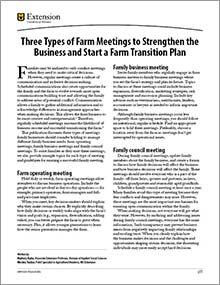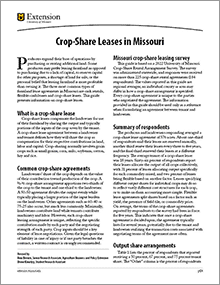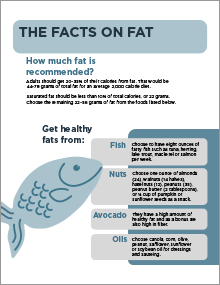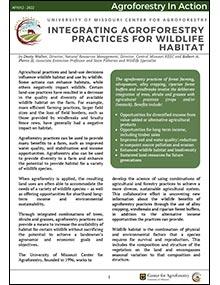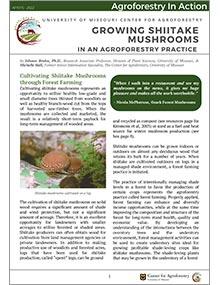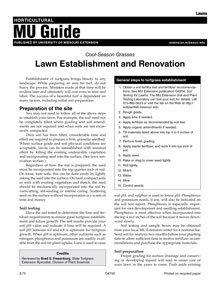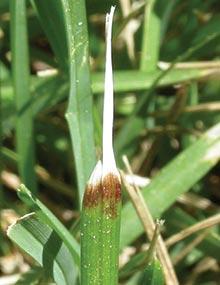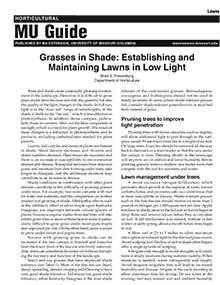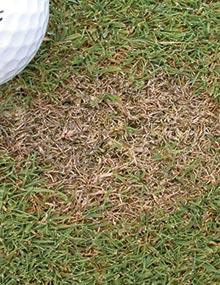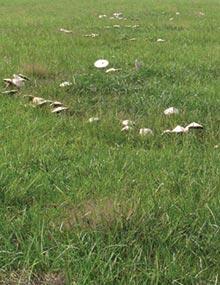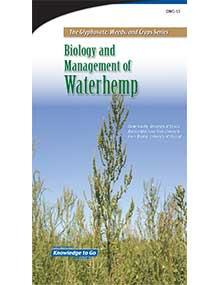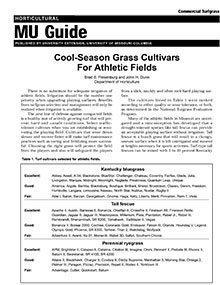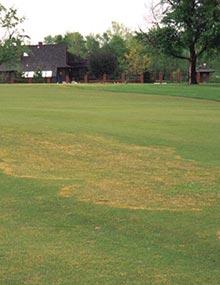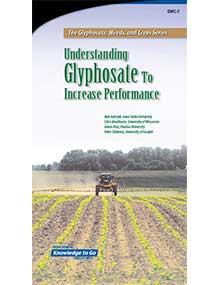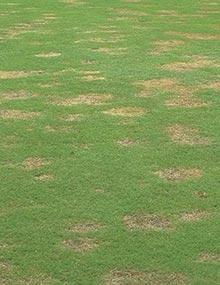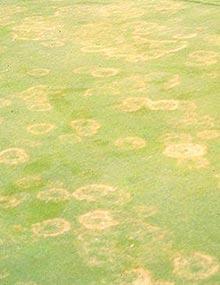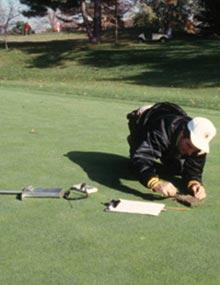Three Types of Farm Meetings to Strengthen the Business and Start a Farm Transition Plan
New
Use operating, business and family council meetings to build a culture of communication and inclusive decision-making in your family business. Find guidelines for running a successful family meeting, and when to use different meetings in this publication.
Crop-Share Leases in Missouri
Revised
Producers expand their base of operations by purchasing or renting additional land. The three most common types of farmland lease agreements in Missouri are cash rentals, flexible-cash leases and crop-share leases. This guide presents information on crop-share leases.
The Facts on Fat Handout (Bundle of 25)
Revised $12
This handout explains how much dietary fat is recommended daily and provides a list of foods with healthy fats. It also discusses saturated fat and provides tips on limiting it.
Tiger Card (Bundle of 50)
Reviewed $26
Editor’s note
The following abstract describes a publication that is only available for purchase.
Integrating Agroforestry Practices for Wildlife Habitat
Revised
Learn how to incorporate management of trees, shrubs and grasses with your current farm practices to benefit white-tailed deer, eastern wild turkey, bobwhite quail, waterfowl and mourning doves.
Economic Budgeting for Agroforestry Practices
Revised
See the steps and examples you can follow to develop enterprise budgets, create a cashflow plan and estimate economic indicators for agroforestry practices.
Growing Shiitake Mushrooms in an Agroforestry Practice
Revised
Cultivating shiitake mushrooms represents an opportunity to utilize healthy low-grade and small-diameter trees thinned from woodlots as well as healthy branch-wood cut from the tops of harvested saw-timber trees. When the mushrooms are collected and marketed, the result is a relatively short-term payback for long-term management of wooded areas.
Cool-Season Grasses: Lawn Establishment and Renovation
Reviewed
Established turfgrass brings beauty to any landscape. The success of a turfgrass lawn depends on many factors, from soil preparation to seeding and watering. Learn steps for creating a beautiful cool-season grass lawn in this University of Missouri Extens
Identification and Management of Turfgrass Diseases, Page 04
Reviewed
Ascochyta leaf blight results in the rapid development of large irregularly shaped, straw-colored patches on Kentucky bluegrass and occasionally on tall fescue and perennial ryegrass during the summer. Because Ascochyta spp. are primarily foliar pathogens, diseased turfgrass usually recovers relatively quickly.
Grasses in Shade: Establishing and Maintaining Lawns in Low Light
Reviewed
Growing grass under trees is hard because the quality as well as the quantity of light changes in the shade. Learn what grass species and cultivars are shade-tolerant and how to manage a shady lawn in this University of Missouri Extension guide.
Identification and Management of Turfgrass Diseases, Page 07
Reviewed
Dead spot is a disease of new sand-based bentgrass greens or renovated greens where methyl bromide was used in the renovation. The disease first occurs one to four years after construction or renovation, gradually disappearing one to three years after its first occurrence.
Identification and Management of Turfgrass Diseases, Page 10
Reviewed
Fairy ring is caused by more than 60 basidiomycete fungi, including those producing the familiar puffballs and toadstools. The rings result from the activities of these fungi growing radially through the thatch or soil, rather than from a direct parasitic relationship with the turfgrass.
Biology and Management of Waterhemp
Reviewed
Editor’s note
The following abstract describes a publication that is only available as a downloadable PDF.
Identification and Management of Turfgrass Diseases, Page 13
Reviewed
Large patch is a cool-season disease of warm-season grasses. Symptoms are most common when these grasses are either entering or coming out of dormancy.
Identification and Management of Turfgrass Diseases, Page 16
Reviewed
Necrotic ring spot is a destructive disease of Kentucky bluegrass, but may also occur on red fescue and annual bluegrass. The disease is particularly damaging to bluegrass.
Understanding Glyphosate to Increase Performance
Review
Editor’s note
The following abstract describes a publication that is only available as a downloadable PDF.
Identification and Management of Turfgrass Diseases, Page 19
Reviewed
Spring dead spot is a destructive disease of common bermudagrass and bermudagrass hybrids throughout the northern range of its adaptation in the U.S.
Identification and Management of Turfgrass Diseases, Page 22
Reviewed
Yellow patch is a cool-season disease that occurs on bentgrass and annual bluegrass putting greens and sometimes on higher-gut Kentucky bluegrass.
Identification and Management of Turfgrass Diseases, Page 02
Reviewed
Accurate diagnosis is the key to managing turfgrass disease in an environmentally and economically sound manner. When the cause is not accurately identified and management practices and control measures are not developed accordingly, inputs are wasted and high reestablishment costs may be incurred.
Identification and Management of Turfgrass Diseases, Page 05
Reviewed
Brown patch is a sheath- and leaf-blighting summer disease that is common on tall fescue and bentgrass. It is particularly severe on tall fescue. With increased use of tall fescue in urban and commercial landscapes, brown patch has become a significant management problem.
Identification and Management of Turfgrass Diseases
Reviewed
This publication is designed to be a useful reference for diagnosticians, turfgrass managers, industry representatives and others who want to learn how to diagnose and manage common turfgrass diseases caused by plant pathogenic fungi.
